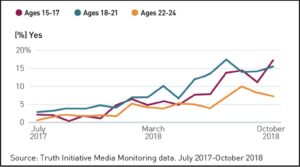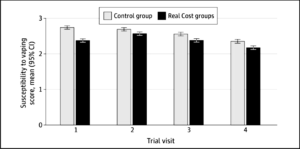In July 2019, the Food and Drug Administration (FDA) released its first anti-vape advertisement focused on teenagers, targeting the rapid growth of vape usage across the nation. Since then, anti-nicotine and anti-e-cigarette ads have flooded teens’ media outlets such as Snapchat, Instagram and Spotify. However, with the growing popularity of vapes and other e-cigarettes among youth in the last two decades, the question still remains of whether these advertisement campaigns remain beneficial, or are a waste of government resources.

According to the Truth Initiative, a nonprofit public health organization dedicated to eradicating commercial nicotine addiction, the brand JUUL first emerged in 2015 and quickly established itself as a leading nicotine vape company with its pod system of nicotine salts. Between July 2017 and October 2018, the use of JUUL increased by 800% in teens ages 15-17 and 400% for individuals ages 18-21, with over 56% of JUUL users claiming to have started before the age of 18.
Additionally, data collected by the FDA for 2023 shows that over 2.8 million youth currently use nicotine products, with vapes being the most popular source for the tenth year in a row. Furthermore, between 2022 and 2023, the percentage of middle school vape users increased from 4.5% to 6.6%, while the percentage of high school users dropped from 16.5% to 12.6%.
This data brings to attention the curiosity of what makes these devices so popular, especially with teens.
At the root of these e-cigarettes’ popularity is their addictive qualities. Nicotine, the drug used within vapes, releases a chemical called dopamine in the same regions of the brain as many other addictive drugs, and causes mood-altering changes within a person’s body and brain that make them temporarily feel “good” and uplifted. This instant gratification creates an attachment for users and an association between positive feelings and vaping. Additionally, the inhaled smoke and fumes from e-cigarettes delivers nicotine to the brain within nearly 20 seconds, making it extremely addictive—comparable to opioids, alcohol and cocaine.
Specifically for youth, nicotine addiction can occur even more rapidly than in adult users because human brains do not fully develop until the age of 25; the part of the brain that is responsible for decision making and impulse control is mid-development. Consequently, before 25, youth are more prone to risk-taking, which can lead to nicotine and other drug addictions. Moreover, these nicotine addictions can be detrimental to teen brain development and can change the ways in which brain synapses are formed, therefore acting as a gateway for other drug addictions later in life.
To combat the psychological and physiological impulses of addiction, the FDA, state and local government organizations have begun anti-vape campaigns across the nation to help slow and ultimately eradicate the usage of vapes, e-cigarettes and nicotine across youth. To do this, organizations use the power of psychology in advertising to persuade youth against vapes. Among many advertising techniques are two significant approaches:
1) Securing a teen’s attention. According to CNN Health, since 2004, the average person’s attention span has decreased from approximately 2.5 minutes to 47 seconds. Additionally, research by Harvard University in partnership with the Brain Balance Organization has observed an even more significant drop among youth ages 12-17. CNN Health also describes how the decrease in attention spans is due to the growing availability of information at our fingertips on platforms such as X (formally known as Twitter), Instagram and many online newspapers. Consequently, advertisement companies have had to transition to short and flashy clips or images in order to effectively communicate their messages. For many anti-vape ads, companies have created five to 15 second clips that include bolded messages, in order to capture a teen’s attention long enough to relay their information.
2) Securing trust. Throughout many anti-vape advertisements, organizations use other teens to communicate their message or share personal testimonies. For example, the Truth Initiative creates anti-vape advertisements that highlight teens’ experiences and/or center teens as the messengers of anti-vape information to their peers. According to The Chicago School, this practice therefore allows viewers to better intake the given information and trust its legitimacy.
Lick-Wilmerding High School Psychology: Brain and Behavior teacher Anton Krukowski views this connection as one of the most crucial components of successful advertising. “At the end of the day, [impactful advertising] comes down to our basic urges to connect and feel wanted,” he said.

In a study conducted by the University of North Carolina, Chapel Hill (UNC) that observed the impact of vaping prevention advertisements from the FDA’s “Real Cost” national campaign on youth, scientists found these ads reduced teens’ susceptibility to vaping compared with control videos. The trial, published in October 2022, included 1514 adolescents between ages 13-17. Throughout the trial, participating adolescents saw three randomly ordered 30-second ad videos online at each of three weekly study visits. The study’s results expressed that those who received Real Cost videos (versus control advertisements) had a noticeably lower susceptibility to vaping by their fourth clinic visit than their peers in the control group.
Ultimately, with their expressed effectiveness, anti-vaping advertising campaigns such as the Real Cost campaign, Smoke Free U.S. and others will continue to arise across different media in hopes of eradicating nicotine addiction among youth across the country.








Escort Gazette review guide with free verified ads in Europe. Best Escort Girls, Strip clubs, Brothels, Massage parlors on the map. Easy search directory. https://cullenh681oam7.lotrlegendswiki.com/user
Escort Gazette review guide with free verified ads in Europe. Best Escort Girls, Strip clubs, Brothels, Massage parlors on the map. Easy search directory. https://bookmarkahref.com/story16964402/escort-gazette-review-guide-with-free-verified-ads-in-europe
Escort Gazette review guide with free verified ads in Europe. Best Escort Girls, Strip clubs, Brothels, Massage parlors on the map. Easy search directory. https://zanebpbn80358.amoblog.com/escort-gazette-review-guide-with-free-verified-ads-in-europe-48037175
Escort Gazette review guide with free verified ads in Europe. Best Escort Girls, Strip clubs, Brothels, Massage parlors on the map. Easy search directory. https://zanexjvh58024.wikiconversation.com/6397313/best_escort_girls_strip_clubs_brothels_massage_parlors_on_the_map_easy_search_directory
Escort Gazette review guide with free verified ads in Europe. Best Escort Girls, Strip clubs, Brothels, Massage parlors on the map. Easy search directory. https://stephenf581pbn8.wikilowdown.com/user
Escort Gazette review guide with free verified ads in Europe. Best Escort Girls, Strip clubs, Brothels, Massage parlors on the map. Easy search directory. https://ebiz-directory.com/listings200448/best-escort-girls-strip-clubs-brothels-massage-parlors-on-the-map-easy-search-directory
Escort Gazette review guide with free verified ads in Europe. Best Escort Girls, Strip clubs, Brothels, Massage parlors on the map. Easy search directory. https://reidhufr91461.tkzblog.com/26217223/escort-gazette-review-guide-with-free-verified-ads-in-europe
Escort Gazette review guide with free verified ads in Europe. Best Escort Girls, Strip clubs, Brothels, Massage parlors on the map. Easy search directory. https://onelifesocial.com/story2189196/escort-gazette-review-guide-with-free-verified-ads-in-europe
Escort Gazette review guide with free verified ads in Europe. Best Escort Girls, Strip clubs, Brothels, Massage parlors on the map. Easy search directory. https://ewartm803ufq9.bloggerswise.com/profile
Escort Gazette review guide with free verified ads in Europe. Best Escort Girls, Strip clubs, Brothels, Massage parlors on the map. Easy search directory. https://2021directory.com/listings198663/best-escort-girls-strip-clubs-brothels-massage-parlors-on-the-map-easy-search-directory
Escort Gazette review guide with free verified ads in Europe. Best Escort Girls, Strip clubs, Brothels, Massage parlors on the map. Easy search directory. https://brucef579kug4.wikinstructions.com/user
Escort Gazette review guide with free verified ads in Europe. Best Escort Girls, Strip clubs, Brothels, Massage parlors on the map. Easy search directory. https://bookmarkinglife.com/story2332984/best-escort-girls-strip-clubs-brothels-massage-parlors-on-the-map-easy-search-directory
Escort Gazette review guide with free verified ads in Europe. Best Escort Girls, Strip clubs, Brothels, Massage parlors on the map. Easy search directory. https://cesarnanz25803.mappywiki.com/632441/escort_gazette_review_guide_with_free_verified_ads_in_europe
Escort Gazette review guide with free verified ads in Europe. Best Escort Girls, Strip clubs, Brothels, Massage parlors on the map. Easy search directory. https://edgarrerc46913.blazingblog.com/26357448/escort-gazette-review-guide-with-free-verified-ads-in-europe
Escort Gazette review guide with free verified ads in Europe. Best Escort Girls, Strip clubs, Brothels, Massage parlors on the map. Easy search directory. https://nebula-directory.com/listings200779/best-escort-girls-strip-clubs-brothels-massage-parlors-on-the-map-easy-search-directory
Escort Gazette review guide with free verified ads in Europe. Best Escort Girls, Strip clubs, Brothels, Massage parlors on the map. Easy search directory. https://aeschylusj792ser9.blog2freedom.com/profile
Escort Gazette review guide with free verified ads in Europe. Best Escort Girls, Strip clubs, Brothels, Massage parlors on the map. Easy search directory. https://abbief579kug4.ambien-blog.com/profile
Escort Gazette review guide with free verified ads in Europe. Best Escort Girls, Strip clubs, Brothels, Massage parlors on the map. Easy search directory. https://bookmarkgenious.com/story17094753/escort-gazette-review-guide-with-free-verified-ads-in-europe
Escort Gazette review guide with free verified ads in Europe. Best Escort Girls, Strip clubs, Brothels, Massage parlors on the map. Easy search directory. https://mariojxju03580.wikitron.com/640315/escort_gazette_review_guide_with_free_verified_ads_in_europe
Escort Gazette review guide with free verified ads in Europe. Best Escort Girls, Strip clubs, Brothels, Massage parlors on the map. Easy search directory. https://mixbookmark.com/story2326289/escort-gazette-review-guide-with-free-verified-ads-in-europe
Escort Gazette review guide with free verified ads in Europe. Best Escort Girls, Strip clubs, Brothels, Massage parlors on the map. Easy search directory. https://socialupme.com/story2341675/best-escort-girls-strip-clubs-brothels-massage-parlors-on-the-map-easy-search-directory
Слоты и онлайн-игры в казино способны разнообразить жизнь человека. Важно только правильно выбрать площадку — она должна быстро и честно выплачивать выигрыши, надежно хранить персональные данные клиентов, предлагать большой ассортимент развлечений и интересную бонусную программу. Важную роль играют также наличие адаптированной мобильной версии и приложений. https://enic-kazakhstan.kz/
Слоты и онлайн-игры в казино способны разнообразить жизнь человека. Важно только правильно выбрать площадку — она должна быстро и честно выплачивать выигрыши, надежно хранить персональные данные клиентов, предлагать большой ассортимент развлечений и интересную бонусную программу. Важную роль играют также наличие адаптированной мобильной версии и приложений. https://enic-kazakhstan.kz/